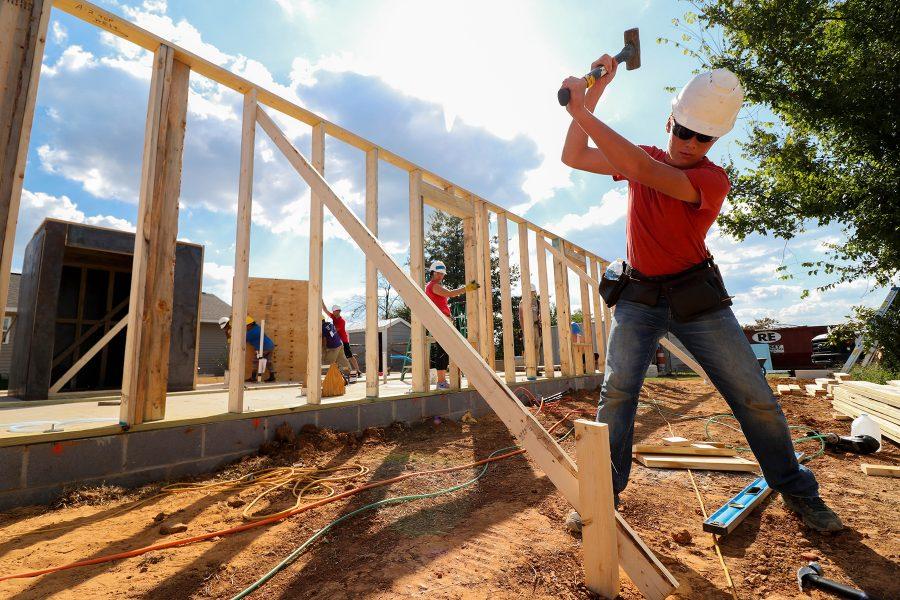After the April 27, 2011 tornado tore through Tuscaloosa, the damaged buildings and homes became a sea of blue tarps, trying to protect what remained of the many homes that were in the tornado’s path. Six years later, much of the city has been rebuilt, but one of those tarps still serves as one Tuscaloosa woman’s makeshift roof.
Habitat for Humanity of Tuscaloosa is seeking to change that.
Sonya Kemp, the homeowner of the new Habitat house, is currently living in a run-down house originally built in 1930 that was in the path of the April 27, 2011 tornado that demolished many of the city’s homes. After complications with the owner of the house, she was denied FEMA aid, leaving her to manage the damage on her own.
With water leaking through light fixtures, her floors are rotting and the toilet is sinking lower and lower each day. Only half of the home has electricity, leaving Kemp with no option but to power the rest of the home through extension cords.
A large blue tarp across the damaged roof serves as Kemp’s only protection from winter climates and rain, though it still allows leaks that have led to mold growing throughout the house, forcing Kemp to stay with relatives when it rains. Often, she will return home to find that the tarp has been torn away from strong winds, leaving her to readjust it herself.
Ellen Potts, executive director for Habitat for Humanity of Tuscaloosa, said that plans for this home have been in the works since last year, but that Kemp has only recently been selected as the homeowner. Kemp originally applied for a home repair program but when a team was sent to evaluate the extent of repairs needed for her home, they determined that it was beyond repair and offered the services of Habitat for Humanity to demolish the old home and rebuild a new one in the same location.
“We talked about building a new home for her in the same location and tearing the old house down,” Potts said. “Most people who apply for a new home, they’ve never been a homeowner before but many people inherit poor homes like Ms. Kemp did. They inherit the house in a horrible condition and it’s all that they’ve ever had.”
Potts said the organization does not give houses away. Rather, they sell them to the homeowners for fair market value with a zero percent interest rate for thirty years. Kemp will also be required to do at least 250 hours of work on her home and other peoples’ Habitat homes. Family, friends and volunteers can aid in the building process.
What sets the Kemp Home project apart from other Habitat Homes is that it is a student-run initiative. From fundraising and marketing, to laying the brick, students will be involved in the project every step of the way.
Laura Ritchie, a marketing master’s applicant at The University of Alabama and marketing assistant with Habitat for Humanity of Tuscaloosa, said donations are still needed to reach the organization’s goal of $100,000 to build Kemp’s new home.
“Most of the donations that we receive for these projects come from large corporations at the national level,” Ritchie said. “But it also makes a big difference at the local level when individuals or businesses contribute money.”
Ritchie also said Habitat is working closely with the University for this project, and the University of Alabama Habitat Tuscaloosa Culverhouse Division allows Greek members to volunteer in the building process for their required volunteer and charity hours through the “Heroes 4 Habitat” student led project.
“Our goal is to grow the affiliation with the University, and there is a Habitat chapter on campus where students actually go volunteer and build,” Ritchie said. “Every single week there’s an opportunity for sorority members to go build on a work site, so the University has contributed greatly as far as students going and building.”
Ritchie said students participate in builds almost every week and that plans are in the works to get more fraternity members involved in volunteering and raising donations.
Kemp said that she is glad and thankful that Habitat selected her as their new homeowner and that she looks forward to living in her future home with her two chihuahuas.
“I’m just blessed that Habitat decided to help me out and anything that people can contribute will be appreciated,” Kemp said. “My biggest thing is that this is helping me get to keep [my dogs] and love them in a safe place. Those are my babies.”
Habitat for Humanity of Tuscaloosa has raised $21,000 to fund the home so far, about a quarter of a way toward their $100,000 goal. Members of the community who are interested in contributing to Kemps home can make donations via Venmo at https://venmo.com/UA-Habitat, or on the organization’s website at https://www.habitattuscaloosa.org/give. If donating through the website, contributors should specify that they want their donation to go toward Kemp’s home.
Habitat for Humanity of Tuscaloosa has received a State Farm matching grant through Habitat for Humanity International. Each donation will be matched for the first $10,000 of donations.
Editor’s note: Jake Stevens, the photographer, is also a public relations intern with Habitat for Humanity. He did not contribute to the reporting of this story.







